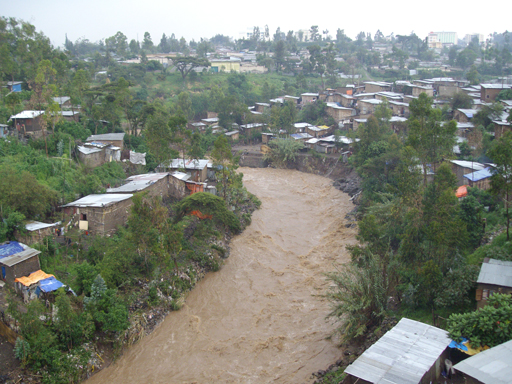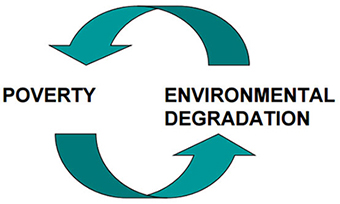2.5 Poverty, population and the environment
Families with many children are more likely to live in poverty with an inadequate diet and poor living conditions. This leads to ill health, which diminishes people’s ability to work and puts them deeper into poverty in a negative downward spiral.
The environment is very important for the well-being of everyone, but particularly poor people because they tend to have a closer relationship with their immediate surroundings than people who are better off. Poor people are more directly dependent on the environment for food, water, fuel and traditional medicines, as well as deriving their income from it through agriculture, forestry or fishery.
Poor people are also more vulnerable to natural disasters such as flood and drought, and to climate change. They may live in undesirable areas such as marshy lands without flood protection, or on unstable hillsides. Poverty means they don’t have the resources to build shelters that can withstand floods and landslides (Figure 2.8). In urban areas they are likely to live in slums with less access to affordable clean water, good sanitation or health facilities.

Poor people cannot afford to buy electricity to meet their energy needs, so they cut down trees for cooking, heating and other purposes. This adds to the problems of deforestation discussed in Study Session 1. Deforestation reduces the resources available from the forest and increases soil erosion and flooding, which in turn reduces productivity and damages crops, making poor people poorer.
For farmers, the lack of capital to invest in environmentally friendly technologies, coupled with constraints of land tenure, make it difficult for them to change their farming practices to safeguard the environment. A degraded environment significantly affects the health of poor communities, which impacts on their livelihoods, as they earn less and have to spend more money on health care.
All of this adds up to the recognition that poverty leads to environmental degradation, which in turn increases poverty in a ‘vicious circle’ (Figure 2.9).

How can the vicious circle be broken? Three things have to be addressed. First, there should be investment to create job opportunities for poor people and increase their income. The government of Ethiopia’s Plan for Accelerated and Sustained Development to End Poverty (PASDEP) of 2006 was designed to lay out the programme for poverty eradication (MoFED, 2006). This has been carried forward with the Growth and Transformation Plans I and II.
Second, education can increase awareness and knowledge of environmental protection. Educated people are more likely to implement good farming practices, such as digging diversion ditches and terraces to prevent soil erosion, and follow proper waste management practices. Understanding the value of good hygiene practices can reduce waterborne diseases. This has an economic gain because better health means improved fitness, more income from work, and less expenditure on medicines.
Third, gender equality is another important way to break the vicious circle between poverty and environmental problems. Women, if they are empowered, will make informed decisions about the environment because they are in close contact with it when they collect wood, manage wastes and fetch water.
These three approaches have combined effects as well, and connect back to population growth. Educated women are more likely to be knowledgeable about contraception, and therefore to choose the size of their families. They will also be better placed to take advantage of new employment opportunities, as well as playing an important role in protecting the environment.
2.4.2 Population growth and health
